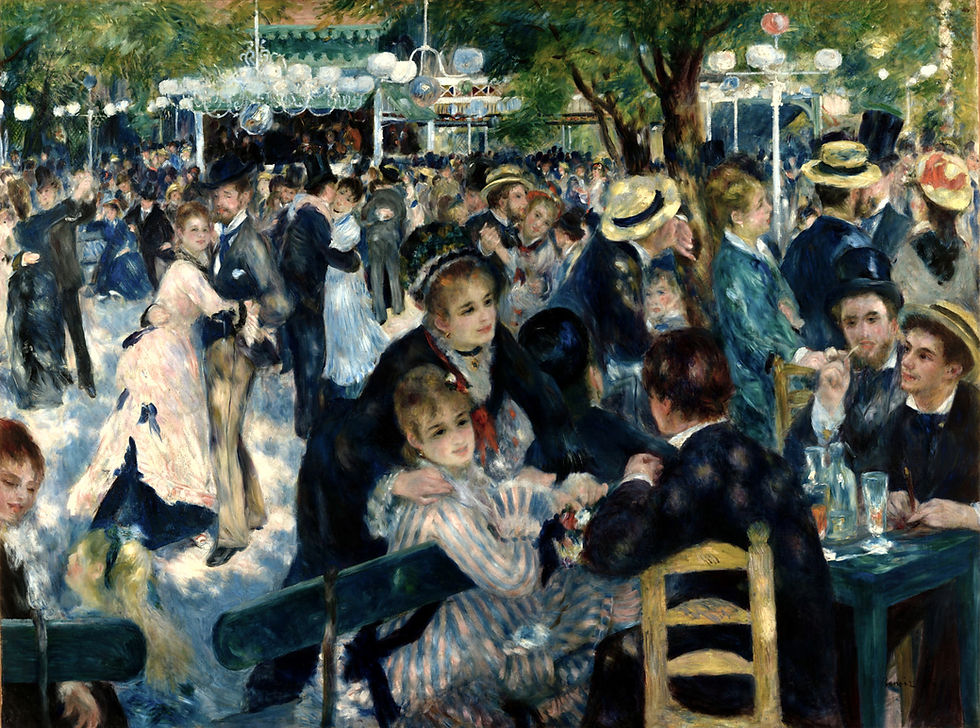Dance at Le Moulin de la Galette: Renoir’s Masterpiece and Its Captivating Story
- icönik

- Mar 16
- 3 min read

Dance at Le Moulin de la Galette – A Snapshot of Joyful Parisian Life
When you think of the Impressionist movement, Pierre-Auguste Renoir’s Dance at Le Moulin de la Galette immediately comes to mind. This vibrant masterpiece, created in 1876, is more than just a painting—it’s a celebration of Parisian leisure, culture, and Renoir’s love for capturing the ephemeral beauty of life.
In this blog post, we’ll dive into the story behind this iconic artwork, explore Renoir’s technique, and discuss why it continues to fascinate art enthusiasts and casual admirers alike.
The Scene: A Slice of 19th-Century Parisian Life
Set in the famous Montmartre district, Dance at Le Moulin de la Galette depicts a Sunday afternoon at an open-air dance hall, where Parisians gathered to enjoy music, food, and camaraderie. The Moulin de la Galette, named after a nearby windmill, was a hotspot for working-class leisure. Renoir’s painting captures the festive atmosphere with couples dancing, friends chatting, and sunlight filtering through the trees.
This joyous representation of leisure life resonates with modern audiences, offering a window into a simpler, more carefree era.
Renoir’s Technique: Mastery of Light and Movement
One of the hallmarks of Dance at Le Moulin de la Galette is Renoir’s use of light. The dappled sunlight streaming through the foliage creates dynamic patterns on the scene below, evoking the warmth and vibrancy of the moment. Renoir’s brushstrokes, loose and fluid, suggest movement—whether it’s a dancer mid-spin or the sway of a skirt.
His palette of soft blues, pinks, and yellows enhances the festive mood. Renoir used live models to add realism and intimacy to the work, many of whom were his friends and acquaintances from Montmartre.
The Legacy of Dance at Le Moulin de la Galette
Since its debut, Dance at Le Moulin de la Galette has been celebrated as one of the finest examples of Impressionism. It perfectly embodies the movement’s emphasis on capturing fleeting moments and the interplay of light and color. The painting is housed at the Musée d’Orsay in Paris, drawing millions of visitors each year.
A smaller version of the painting, also by Renoir, sold for over $78 million in 1990, highlighting its enduring value in the art world.
Fun Facts About the Painting
The Moulin Today: The original windmill still stands in Montmartre, and the area remains a popular tourist destination.
A Social Commentary: While the painting exudes joy, some art historians see it as a subtle commentary on the blending of social classes in 19th-century Paris.
Renoir’s Friends: Many of the people in the painting were Renoir’s close friends, including fellow artists and local models.
Why It’s a Google Discover Favorite
Dance at Le Moulin de la Galette combines art history, cultural insight, and visual storytelling—elements that make it a perfect topic for Google Discover. Readers searching for art, history, or Parisian culture will find value in exploring the story behind Renoir’s masterpiece.
Conclusion: A Timeless Celebration of Life
Renoir’s Dance at Le Moulin de la Galette isn’t just a painting—it’s a joyful celebration of humanity, art, and the fleeting moments that make life beautiful. Whether you’re an art aficionado or simply love exploring cultural gems, this masterpiece offers something for everyone.
Next time you’re in Paris, don’t miss the chance to see this iconic work in person at the Musée d’Orsay. You’ll not only witness the brilliance of Renoir but also feel transported to a sunny afternoon in 19th-century Montmartre.












































Comments